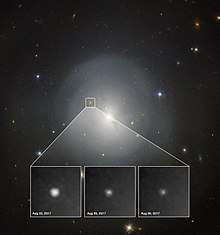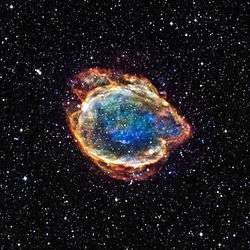Kilonova
A kilonova (also called a macronova or r-process supernova) is a transient astronomical event that occurs in a compact binary system when two neutron stars or a neutron star and a black hole merge into each other. Kilonovae are thought to emit short gamma-ray bursts and strong electromagnetic radiation due to the radioactive decay of heavy r-process nuclei that are produced and ejected fairly isotropically during the merger process.[1]
The term kilonova was introduced by Metzger et al. in 2010[2] to characterize the peak brightness, which they showed reaches 1000 times that of a classical nova. They are 1/10th to 1/100th the brightness of a typical supernova, the self-detonation of a massive star.[3]
The first kilonova to be found was detected as a short gamma-ray burst, sGRB 130603B, by instruments on board the Swift Gamma-Ray Burst Explorer and KONUS/WIND spacecrafts and then observed using the Hubble Space Telescope.[1]
Theory
The inspiral and merging of two compact objects are a strong source of gravitational waves (GW).[2] Kilonovae are thought to be progenitors of short gamma-ray bursts[2] (GRB) and the predominant source of stable r-process elements in the Universe.[1] The basic model for neutron star mergers was introduced by Li-Xin Li and Bohdan Paczyński in 1998.[4]
Observations

The first observational suggestion of a kilonova came in 2008 following the short-hard gamma-ray burst GRB 080503[6], where a faint object appeared in optical and infrared light after one day and rapidly faded. Another kilonova was suggested in 2013, in association with the short-duration gamma-ray burst GRB 130603B, where the faint infrared emission from the distant kilonova was detected using the Hubble Space Telescope.[1]
On October 16, 2017, the LIGO and Virgo collaborations announced the first simultaneous detections of gravitational waves (GW170817) and electromagnetic radiation (GRB 170817A, SSS17a) of any phenomena,[7] and demonstrated that the source was a kilonova caused by a binary neutron star merger.[8] This short GRB was followed by a longer transient visible for weeks in the optical electromagnetic spectrum (AT 2017gfo) located in a relatively nearby galaxy, NGC 4993.[9]
See also
References
- 1 2 3 4 Tanvir, N. R.; Levan, A. J.; Fruchter, A. S.; Hjorth, J.; Hounsell, R. A.; Wiersema, K.; Tunnicliffe, R. L. (2013). "A 'kilonova' associated with the short-duration γ-ray burst GRB 130603B". Nature. 500 (7464): 547–9. arXiv:1306.4971. Bibcode:2013Natur.500..547T. doi:10.1038/nature12505. PMID 23912055.
- 1 2 3 Metzger, B. D.; Martínez-Pinedo, G.; Darbha, S.; Quataert, E.; Arcones, A.; Kasen, D.; Thomas, R.; Nugent, P.; Panov, I. V.; Zinner, N. T. (August 2010). "Electromagnetic counterparts of compact object mergers powered by the radioactive decay of r-process nuclei". Monthly Notices of the Royal Astronomical Society. 406 (4): 2650. arXiv:1001.5029. Bibcode:2010MNRAS.406.2650M. doi:10.1111/j.1365-2966.2010.16864.x.
- ↑ "Hubble captures infrared glow of a kilonova blast". spacetelescope.org. 5 August 2013. Retrieved 28 February 2018.
- ↑ Li, L.-X.; Paczyński, B.; Fruchter, A. S.; Hjorth, J.; Hounsell, R. A.; Wiersema, K.; Tunnicliffe, R. (1998). "Transient Events from Neutron Star Mergers". The Astrophysical Journal. 507 (1): L59–L62. arXiv:astro-ph/9807272. Bibcode:1998ApJ...507L..59L. doi:10.1086/311680.
- ↑ "Hubble observes source of gravitational waves for the first time". www.spacetelescope.org. Retrieved 18 October 2017.
- ↑ Perley, D. A.; Metzger, B. D.; Granot, J.; Butler, N. R.; Sakamoto, T.; Ramirez-Ruiz, E.; Levan, A. J.; Bloom, J. S.; Miller, A. A. (2009). "GRB 080503: Implications of a Naked Short Gamma-Ray Burst Dominated by Extended Emission". The Astrophysical Journal. 696 (2): 1871–1885. arXiv:0811.1044. Bibcode:2009ApJ...696.1871P. doi:10.1088/0004-637X/696/2/1871.
- ↑ Abbott, B. P.; Abbott, R.; Abbott, T. D.; Acernese, F.; Ackley, K.; Adams, C.; Adams, T.; Addesso, P.; Adhikari, R. X.; Adya, V. B.; et al. (LIGO Scientific Collaboration & Virgo Collaboration) (16 October 2017). "GW170817: Observation of Gravitational Waves from a Binary Neutron Star Inspiral". Physical Review Letters. 119 (16): 161101. arXiv:1710.05832. Bibcode:2017PhRvL.119p1101A. doi:10.1103/PhysRevLett.119.161101. PMID 29099225.
- ↑ Miller, M. Coleman (16 October 2017). "Gravitational waves: A golden binary". Nature. News and Views (7678): 36. Bibcode:2017Natur.551...36M. doi:10.1038/nature24153.
- ↑ Berger, E. (16 October 2017). "Focus on the Electromagnetic Counterpart of the Neutron Star Binary Merger GW170817". Astrophysical Journal Letters. Retrieved 16 October 2017.

